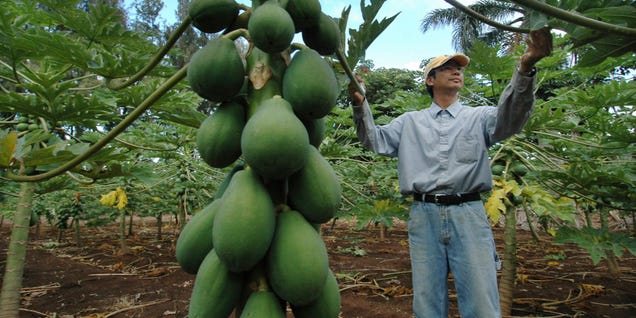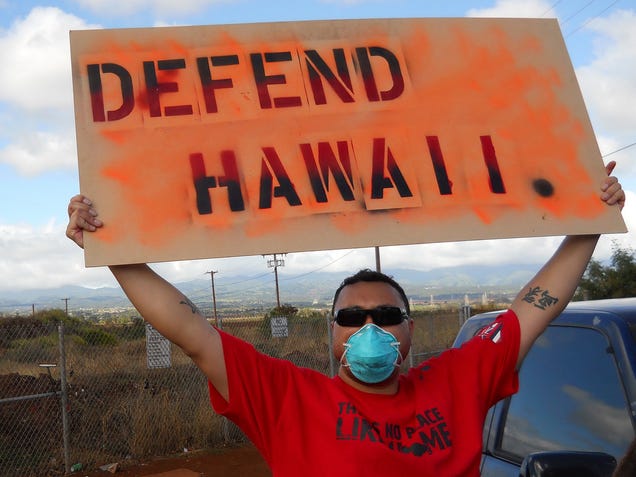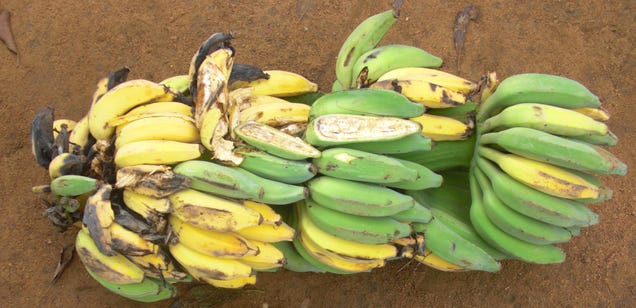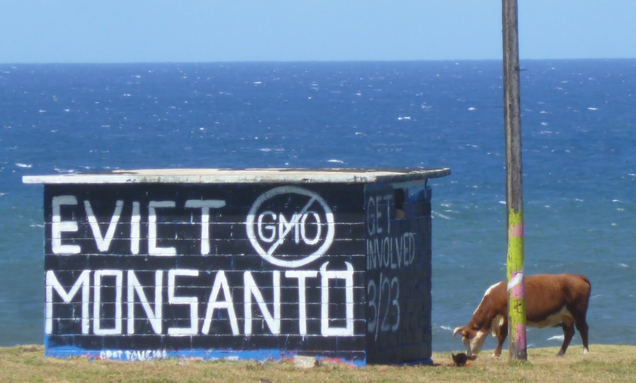If You Want a Glimpse of the Future Food Wars, Look to Hawaii

by Mark Strauss, IO9.com
After Hawaii County banned GMO crops, local farmers say they have no idea whether their plants are illegal or not. Plus, it's unclear whether the county even has the right to enforce this ban in the first place. The Aloha State is about to become ground zero for the U.S. food wars.
Hawaii might seem an unlikely battleground for genetically modified crops, given that the state imports 85 percent of its food. But the subtropical climate—which is ideal for cash crops such as papayas, bananas and orchids—is also a thriving environment for weeds, insects and diseases. The papaya industry was nearly decimated by the ringspot virus in the 1990s, until scientists engineered a disease-resistant variety, the "Rainbow papaya." In short, this is a state where farmers appreciate what GM crops have to offer.
And, the GMO producers appreciate what Hawaii's climate has to offer. All the major agrotech companies are there because developing a new seed variety can require 10 to 12 growth cycles—which translates into 10 to 12 years on the mainland. In sunny Hawaii, 2 to 4 growth cycles can be squeezed into into a single year, significantly reducing the time required to bring seeds to market. Seed crops in Hawaii are worth more than $200 million—and most of those seeds are GM corn being developed for traits such as drought-resistance. An estimated 90 percent of all corn grown in the U.S. has been genetically modified, and each of those seed varieties spent some time being field tested in Hawaii.
Small wonder, then, that Hawaii would be fertile ground for anti-GMO activism—which is, in part, a product of the state's demographics. As historian Rachel Laudan, author of The Food of Paradise: Exploring Hawaii's Culinary Heritage and Cuisine and Empire, recently observed:
Underlying the debate about GMOs in Hawaii is, I suspect, a tension between those who have lived in the islands for generations and newcomers from the mainland. For the locals, the islands have always been a place of high tech agriculture. Many of them worked on the big sugar and pineapple plantations. They saved to buy small plots of land. Those who farm these plots know that the papaya growers have survived thanks to genetically modified varieties that have been safely used since the 1990s.
Indeed, the campaign to ban GMO crops in the County of Hawaii (the "Big Island") was led by Councilwoman Margaret Wille—neither a farmer nor a native Hawaiian, but a public advocacy attorney in Maine who moved ten years ago to the island, where her brothers had once owned a health food store.
Laying down the law

Last May, Wille introduced a bill to ban all genetically modified crops on the Big Island, and revealed her propensity to speak in the anti-corporate, back-to-nature lingo that has become de rigueur among anti-GMO activists. "Do we want dust-bowl monoculture owned by multinationals or do we want to have small, diversified farming on this island?," she asked in West Hawaii Today. And, commenting in the newspaper, Honolulu Civil Beat, "We are part of a web of life and affecting genes affects not only current populations but those of our children and their children."
The Council held months of public hearings on the bill. As the New York Times reported:
At the hearing on Sept. 23….Council members declined to call several University of Hawaii scientists who had flown from Oahu, instead allotting 45 minutes to Jeffrey Smith, a self-styled expert on GMOs with no scientific credentials.
Many University of Hawaii scientists had already registered their opposition to the bill, in written and oral testimony and letters in the local papers…. But Ms. Wille had largely dismissed the opinions of university researchers…."It is sad that our state has allowed our university departments of agriculture to become largely dependent upon funding grants from the multinational chemical corporations," Ms. Wille told reporters, suggesting that the university's professors were largely a "mouthpiece for the GMO biotech industry."
[Meanwhile], Mr. Smith, known for "Genetic Roulette," a movie he produced based on his book of the same title that had been shown at one of the island's "March Against Monsanto" events, appeared at the hearing by Skype from Arizona.
He praised the Council for stepping in where he believes that federal regulatory agencies have failed, and suggested that the Rainbow papaya could harm people because of a protein produced by the viral gene added to it, adding that no human or animal feeding studies had ever been conducted on the fruit.

According to Academics Review, Smith claims he has documented 65 health risks, associated with GMOs—and not one of themhas been found to be scientifically valid. Oh, Smith also claims to have mastered the ancient yogic art of self-levitation. (Yes, he flies.)
It was on the basis of such expert testimony that, last December, the Big Island's anti-GMO bill became law, forbidding any open-air testing or production of genetically modified crops. It also prohibits farmers from growing any new GMO crops. Anyone who violates the measure will be fined $1,000 per day.
An exemption was made for GMO papaya farmers, since their crops, according to the legislation, are already too pervasive to control. (Although Hawaii resident and Special Guest Idiot Roseanne Barr suggested burning the papayas and providing the farmers with assistance until they could "grow something decent.") Still, the farmers were given a March 2014 deadline to register their fields with a detailed description of where each of them is located—and, also, to provide the names of all field employees. Papaya farmers would be required to pay an annual $100 registration fee per field.
Reaping the consequences
So, where do things stand seven months later?
For starters, the papaya farmers gave Councilwoman Wille the finger. In an open letter they declared:
Any anti-GMO legislation would sharply limit the tools that Hawaii farmers can use to produce their crops, and by association it would taint Hawaii's worldwide reputation for the highest quality papaya. The real intent of local anti-GMO legislation is to prohibit all GMO's and to ultimately destroy Hawaii's papaya industry.
Ms. Wille may have political, philosophical or religious reasons for banning GMOs on Hawaii Island, but any claim based on safety to human consumption and the environment is not supported by scientific evidence.
To that end, one papaya farmer has filed a lawsuit with the Hilo Circuit Court that seeks to stop the mandatory registration. The Court has granted a temporary restraining order.
And, what about genetic research? The law doesn't impact the large companies, since they don't have any open-air facilities on the Big Island. But, for universities, it's a different matter. As the Hawaii Tribune-Herald recently reported:
"It will prevent us from using biotech as a solution" to agricultural issues, said Russell Nagata, Hawaii County administrator for the University of Hawaii's College of Tropical Agriculture and Human Resources.
Scientists interviewed say it is necessary to grow modified crops outdoors to test their effectiveness. Under the county's law, testing can occur but it must be done indoors.
Nagata said his Hilo-based office was not conducting research on genetic engineering when the law was enacted.
For those with projects already in progress, the law provides less certainty.
Michael Shintaku, a plant pathologist at the University of Hawaii at Hilo, said he is continuing his research on creating genetically modified lettuce resistant to the tomato spotted wilt virus but is unsure of whether he can get it approved with the current restrictions.
The virus is transported by insects, and he thinks he can create resistance through processes similar to what allowed Rainbow papaya to be resistant to the ringspot virus.
"We are just kind of waiting to see what happens," Shintaku said.
And the farmers? Well, since their crops are always at risk of being one disease away from complete ruin, they're also kind of screwed. Researchers, for instance, have begun working on GM varieties of bananas that would be resistant to diseases such as the "bunchy top virus" and Race 4 Fusarium Wilt. Even if those banana varieties could be developed, growers would be prohibited from using them.

Likewise, floriculturists and nursery owners are currently working with a USDA research center on the Big Island to develop a new GM variety of anthurium (flowering plants) resistant to two prevalent pests, bacterial blight and nematodes. That research project will likely stop.
Even livestock farmers are affected. Imported feed is expensive, and they had hoped to develop a GM variety that they could grow on the island with a minimal amount of acreage. That's not going to happen.
What also frustrates the farmers is that the crop ban appears to be motivated by more than misguided concerns about public safety. Frequently, the law is presented as part of a wider endeavor in social engineering—an opportunity to transform the modern agricultural industry into a statewide commune.
As Michael Kramer, co-founder of the Hawaii Alliance for a Local Economy, wrote in an editorial:
The truth is that GMO and chemical agriculture is not needed to feed the world, we can do it the way nature intended, not just organically but through proper design. This requires that we collectively decide that the purpose of farming is not monocrop commodities for export on our limited prime agricultural lands.
We need to work as an island community—farmers, economic development organizations, County government, food wholesalers and retailers, restaurants, and citizens to cooperatively design a system that can shift the agricultural system to focus on local production and consumption that meets out needs.
Michael Shintaku, a professor of Plant Pathology at the UH-Hilo College of Agriculture, Forestry and Natural Resources Management, offered a dissenting view:
The Hawaii County Council discouraging papaya or any food farming is a ridiculous concept, but they've done so and at great expense. Are we really growing so much food here that we need to cull some sectors?
If the Hawaii County Council believes that one kind of farming is superior to another (this bill says as much), they should put resources into encouraging organic agriculture. But they shouldn't discourage conventional agriculture. Organic and conventional agricultural systems can and do coexist, and sometimes the organic system benefits from a neighboring conventional one.
Taking precaution too far?
In June, a second lawsuit was filed. This time, it was in U.S. District Court, and the plaintiffs were several Big Island agriculture groups and farmers.
As banana grower Richard Ha explained in an editorial he wrote for West Hawaii Today:
You may be interested to know the inside scoop about the lawsuit Big Island farmers brought against Hawaii County.
We did it for clarity. We thought that the feds and the state had jurisdiction, not the county. We want clarity about the rules of the game. Farmers are law-abiding citizens and we play by the rules.
And we want equal treatment: Only Big Island farmers are prohibited from using biotech solutions that all our competitors can use. That's discriminatory against local farmers.
The central issue of the lawsuit is that the blanket prohibition against GM crops is predicated upon the "precautionary principle." The legislation states that "if a new technology poses threats of harm to human or environmental health, the burden of proof is on the promoter of the technology to prove that the technology is safe."
But, the lawsuit argues those burdens already are met through the federal regulatory process. That includes oversight from the U.S. Department of Agriculture, Food and Drug Administration, and, at least in some cases, the Environmental Protection Agency. According to the plaintiffs, the legislation "puts the County in direct conflict with determinations made after careful consideration by expert federal agencies, and purports to outlaw agricultural activities that the federal government has specially authorized after performing a thorough scientific review."
And here is where we're treading into uncertain legal territory. As the Library of Congress explains:
The United States does not have any federal legislation that is specific to genetically modified organisms (GMOs). Rather, GMOs are regulated pursuant to health, safety, and environmental legislation governing conventional products. The U.S. approach to regulating GMOs is premised on the assumption that regulation should focus on the nature of the products, rather than the process in which they were produced.
In effect, the legal dispute is predicated on whether states and local governments can demand that GMOs meet stricter standards for health and safety than those stipulated by federal regulatory agencies. Legal scholars are divided, with some arguing that anti-GMO laws are unconstitutional:
Courts have previously found that consumer education and protection is a legitimate state interest. This interest lies within the states' police power to protect its citizens' health and welfare. However, it is unclear whether GMOs pose any threat to health and welfare. If GMOs pose no greater risk than traditional food, it casts doubt on states' ability to regulate them separately under the guise of consumer protection.
The FDA maintains that genetically engineered foods do not present any "different or greater safety concerns" than conventionally bred foods. Courts give significant deference to the FDA's scientific judgment, and therefore would be unlikely to find substantial state interest unless presented with scientific evidence of safety risks.
Meanwhile, an opposing legal view argues:
Claims of rigorous regulation are not borne out in practice. The United States does not have a comprehensive regulatory scheme that considers all of the likely risks associated with GM crops prior to approval or, for that matter, on an on-going basis. Numerous reasons exist to bring more rigorous regulatory scrutiny to GM organisms….in the absence of such a regulatory scheme, critical risks associated with these cracks escape regulatory scrutiny. The end result is that private actors, motivated by short-term interests, are able to engage in conduct that imposes risks on wider society without any democratic consideration of the acceptability of those risks.
What we might end up seeing, therefore, are drawn out legal battles where the rights of states to impose anti-GMO laws could be based upon whether the existing regulatory system is deemed competent enough to determine that GMOs pose no health risks or, more significantly, whether sufficient scientific evidence exists to raise reasonable doubts about the safety of GMOs.

The battle will only get more intense, now that the big biotech companies are lawyering up. In Hawaii, anti-GMO legislation has spread to the island of Kauai and, most recently, a group of Maui County residents collected enough valid signatures to place a ban on genetically modified crops on the ballot this coming fall. Both Monsanto and Dow AgroSciences have an extensive presence in Maui, and Monsanto has said that the ban, if passed, "could devastate the company's operations."
So, if you want know the future of agriculture in the U.S., keep an eye on legal developments in Hawaii.
"This is a national movement," Hawaii Attorney General David Louie said at the recent gathering of attorneys general in Washington. "Don't think that it's not coming to you."
---30---